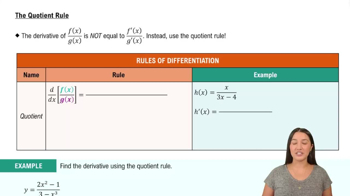Table of contents
- 0. Functions7h 52m
- Introduction to Functions16m
- Piecewise Functions10m
- Properties of Functions9m
- Common Functions1h 8m
- Transformations5m
- Combining Functions27m
- Exponent rules32m
- Exponential Functions28m
- Logarithmic Functions24m
- Properties of Logarithms34m
- Exponential & Logarithmic Equations35m
- Introduction to Trigonometric Functions38m
- Graphs of Trigonometric Functions44m
- Trigonometric Identities47m
- Inverse Trigonometric Functions48m
- 1. Limits and Continuity2h 2m
- 2. Intro to Derivatives1h 33m
- 3. Techniques of Differentiation3h 18m
- 4. Applications of Derivatives2h 38m
- 5. Graphical Applications of Derivatives6h 2m
- 6. Derivatives of Inverse, Exponential, & Logarithmic Functions2h 37m
- 7. Antiderivatives & Indefinite Integrals1h 26m
- 8. Definite Integrals4h 44m
- 9. Graphical Applications of Integrals2h 27m
- 10. Physics Applications of Integrals 2h 22m
3. Techniques of Differentiation
The Chain Rule
Problem 3.38
Textbook Question
9–61. Evaluate and simplify y'.
y = (v / v+1)^4/3
 Verified step by step guidance
Verified step by step guidance1
Step 1: Identify the function y = \left(\frac{v}{v+1}\right)^{\frac{4}{3}} and recognize that it is a composite function, which suggests the use of the chain rule for differentiation.
Step 2: Apply the chain rule. The chain rule states that if you have a composite function y = f(g(v)), then the derivative y' = f'(g(v)) \cdot g'(v). Here, let u = \frac{v}{v+1}, so y = u^{\frac{4}{3}}.
Step 3: Differentiate the outer function with respect to u. The derivative of u^{\frac{4}{3}} with respect to u is \frac{4}{3}u^{\frac{1}{3}}.
Step 4: Differentiate the inner function u = \frac{v}{v+1} with respect to v. Use the quotient rule: if u = \frac{a}{b}, then u' = \frac{a'b - ab'}{b^2}. Here, a = v and b = v+1, so a' = 1 and b' = 1.
Step 5: Combine the results from Steps 3 and 4 using the chain rule. Multiply the derivative of the outer function by the derivative of the inner function to find y'.
 Verified video answer for a similar problem:
Verified video answer for a similar problem:This video solution was recommended by our tutors as helpful for the problem above
Video duration:
4mPlay a video:
Was this helpful?
Key Concepts
Here are the essential concepts you must grasp in order to answer the question correctly.
Differentiation
Differentiation is a fundamental concept in calculus that involves finding the derivative of a function. The derivative represents the rate of change of the function with respect to its variable. In this case, we need to apply differentiation rules to the given function y to find y'.
Recommended video:

Finding Differentials
Chain Rule
The Chain Rule is a technique used in differentiation when dealing with composite functions. It states that the derivative of a composite function is the derivative of the outer function multiplied by the derivative of the inner function. This rule will be essential for differentiating the function y = (v / (v + 1))^(4/3) since it involves a power and a quotient.
Recommended video:

Intro to the Chain Rule
Quotient Rule
The Quotient Rule is a specific rule for differentiating functions that are expressed as the ratio of two other functions. It states that if you have a function in the form of f(v) = g(v) / h(v), the derivative f'(v) is given by (g'(v)h(v) - g(v)h'(v)) / (h(v))^2. This rule will be necessary to differentiate the function y, which is a quotient of two expressions.
Recommended video:

The Quotient Rule

 5:02m
5:02mWatch next
Master Intro to the Chain Rule with a bite sized video explanation from Callie
Start learningRelated Videos
Related Practice






